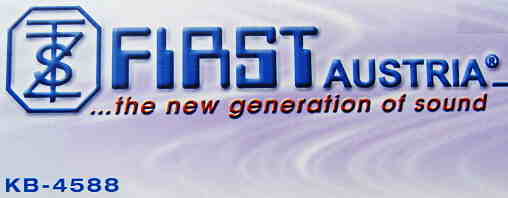
digital lo-fi keyboard with many nice demos, play teaching & MIDI- out
 |
KB-4588
digital lo-fi keyboard with many nice demos, play teaching & MIDI- out |
Although this digital midsize tablehooter has MIDI- out and 50 nice demos with play teaching through a large LCD, the sound is made from really boring low resolution loop samples with much aliasing distortion in high notes due to too low DAC output frequency.
Most of the 50 preset sounds employ a very short looped lo-fi sample with a very simple volume envelope, and many sound not remotely like what their name suggests, which is not least caused by the too slow attack phase of picked strings. The timbre quality can be compared best with the cheap Sankai 01504H, although the MC-36 not even has chorus nor vibrato effects and thus sounds really boring. Interesting is only that the note length of most decaying sounds strongly depends on the note pitch despite most samples are looped anyway. Notes of trilled keys here also occupy each a new sound channel, which makes a nice phasing and volume increase effect. But despite fancy sound names it includes no remotely unusual synth sounds, thus this keyboard badly reminds me to the lousy Bontempi KS 4600 sound bank tablehooter.
Like with the MC-32, the sustain button only simulates a delayed key release instead changing the envelope and the percussion has 5 user- assignable drumpad buttons selecting from 16 thin and hissy sounding lo-fi percussion samples. The 30 preset rhythms have fill-in, but no intro/ ending and also in fingered mode the instrument refuses to play anything beside standard establishment chords; with rhythm off the chord section only plays a boring vibraphone sound. The stereo speakers sound dull and have a really unpleasant tubby roaring midrange resonance like a stereo bass box that is loudly playing inside a locked cupboard or car. Annoying is that the volume can not be set lower than medium room volume.
The manual and box of my specimen calls it First Austria KB-4588, but the case bottom sticker and PCB numbers call it by its genuine name MC-36. This instrument was also released as Medeli MC-36 (the genuine manufacturer?) and Mc Crypt MC-36 (also in silver metallic?). A version with a more rectangular silver (goldish?) case and different LCD was released as Gruhner 6034 and a silver fullsize version as Silverstar Golden Ton and McCrypt MC-49 (seen on eBay).
Despite all standard features of a modern sound bank beginners keyboard are there (including MIDI- out, but no velocity) and it looks fairly noble, I consider this thing rather suitable for play training than for making music. Some tekkno people still may enjoy the coarse lo-fi timbres, but things like the many My Music Center variants or the Casio SA-series keyboards IMO sound much more spectacular for this. Especially watch out not to pay too much for this tablehooter; on eBay the different variants go for very different prices, and in the German mail order shop Conrad Elektronik the Mc Crypt MC-36 costs regularly only 39€.
Another silver metallic version of the original MC-36 was even released (for more than twice the price!) under the Casio brand as Casio MA-150 and MA-170 (seen on eBay). I am not sure if these are entirely identical, but they look exactly so, which is really a shame regarding that Casio has formerly made so much better sounding digital midsize keyboards with very complex programmed synth sounds like the cheap Casio MA-130 100 ToneBank and the wonderful clear sounding MIDI keyboard Casio MT-540. Regarding the progress of integration density it can not be that difficult to shrink the external ROM and MIDI interface of the Casio MT-540 into a cheap single chip CPU to produce it similarly cheap like an MC-36, and adding some more software for more sounds and and a song bank into the internal ROM wouldn't be that difficult either. (The original Casio keyboards were designed in 1980th where 128KB ROM was luxury, while nowadays a few GB are technically possible in expensive instruments.) In former times Casio even sold their own keyboard hardware to other companies, thus Casio's decision to resell a MIDI keyboard by Medeli(?) with this thin sounding MC-36 COB CPU (containing something like an 8 channel My Music Center sound generator with only a few dozen KB more ROM and no chorus to increase polyphony?) for twice its normal price really will not help to improve the Casio brand reputation in any way. (Why didn't they also replace their own SA-65 with the Jin Xin JX-20165?! ;-) )
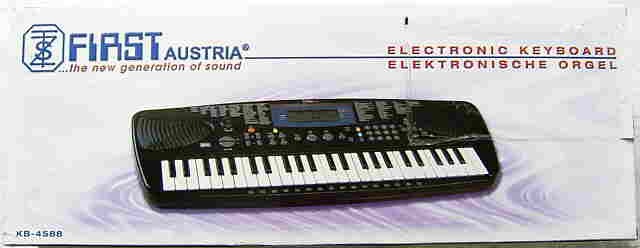 |
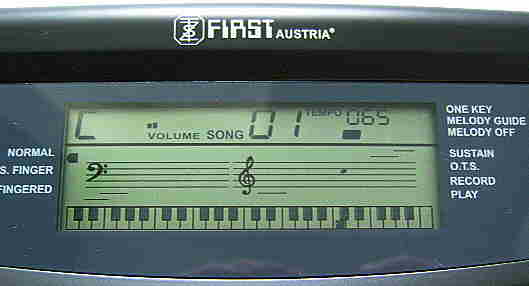 |
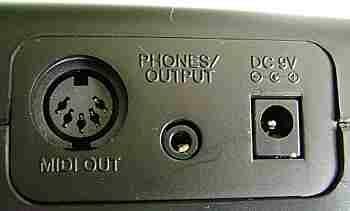 |
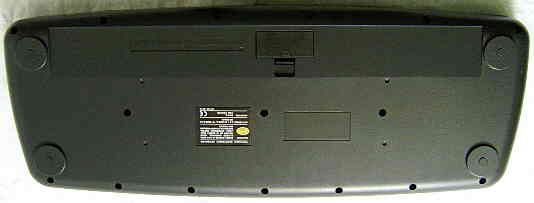 |
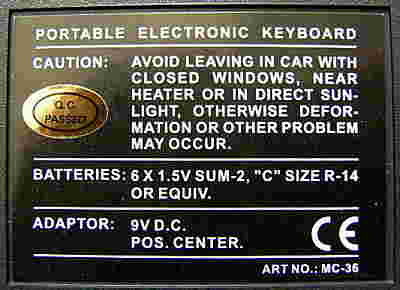 |
 |
 |
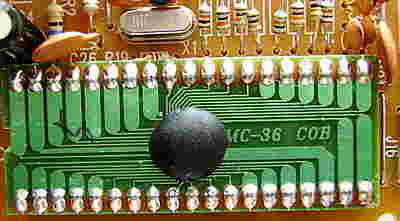 |
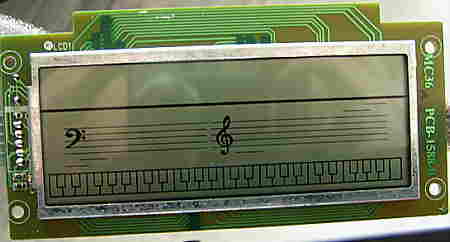 |
The main voice preset sounds employ low and medium resolution samples; most are very short looped or even static waveforms with very simple volume envelope and no vibrato. By too slow attack phases most picked strings sound unrealistic and resemble the infamous "guitar" on Casio VL-Tone 1. Generally many sounds are not remotely like what the name suggests, and the low DAC output frequency distorts high notes by aliasing noise. Instead of decaying faster, many sounds stop with a sudden quiet popping noise shortly after key release. Also the sustain button only simulates a delayed key release instead of prolonging the envelope. Despite most samples are looped, with most decaying sounds the note length strongly changes with the pitch (the lower, the longer). Nice is that when a key is trilled with sustaining sounds, each new note occupies a new sound channel, which produces a great phasing sound and volume increase effect although this eats up polyphony.
The "grand piano" is the most complex sound; it resembles the Sankai 01504H "piano" and has 4 split zones; after key release the decay phase stops with a pop. The "electric piano 1" sounds semi- metallic (high notes more like a nylon guitar); 2 sounds with short notes like a banjo. "harpsichord 1" has a way too slow attack rate for a picked string and is too dull, thus it rather resembles a decaying horn timbre; 2 sounds thinner (more realistic) but has still too slow attack. "vibraphone" is ok but has no vibrato and the timbre is a little harp- like. "marimba" has too slow attack and resembles a short acoustic guitar note. The "draw organ" has slow attack and some sustain (the lower, the longer), thus it rather resembles a dull metal(?) pipe organ rank. The "percussive organ" is the same in brighter, but not more percussive; the attack is more like a violin. Also "jazz organ" 1..2 have slow attack, but also short sustain; the timbre is quite synthetic (a little reedy?) by the low sample resolution. "church organ" is a bright metal pipe organ rank with sustain (the lower, the longer). "reed organ" is a quite dull one. "accordion" otherwise has a quite percussive attack (with some decay before it holds) and rather resembles a reedy e-organ. "harmonica" is the same in duller. "nylon guitar" is an acoustic one. "steel guitar" is brighter with shorter sustain (not the table instrument from country musics, but normal steel string guitar). "clean guitar" sounds like a banjo (thin, hollow and sonorous). "distortion guitar" is bright but not really distorted. "electric guitar 1" resembles a dull and hollow one; 2 is brighter. "accoustic bass" likely should be a dull bowed cello than fades silent, but it rather resembles a sonorous horn or tuba. "finger bass" is a sonorous e-bass; "slap bass" is brighter and more banjo- like, but attack is too dull (bass notes have much sustain). Also "electric bass" sounds sonorous and behaves that way. The "violin" slowly fades silent and lacks vibrato. "pizzicato strings" resembles a dull and fast decaying guitar. "harp" sounds a bit thin; bass range is pale and hollow. "string ensemble 1" is a looped string orchestra sample with noticeably popping loop point. 2 rather resembles a thin oboe or bassoon with scratchy zipper noise during attack. "trumpet" is just a tooting static waveform with semi- percussive attack and some decay before it holds; the timbre is more like a thin violin sample. "trombone" seems to be identical with the latter (possibly a tiny attack variation??). "tuba" is way too thin and rather resembles a saxophone (bass range has much sustain). "french horn" is too thin and sonorous and rather resembles an oboe or badly synthesized violin. "brass section 1" resembles a bright oboe or saxophone with quite percussive attack; 2 is much thinner and a bit woodier. The 2 "sax" sounds are similar but less thin (with scratchy zipper noise during attack). "bassoon" sounds sonorous (like intended); also the "clarinet" is ok. The "piccolo" sounds more like a thin harmonica timbre with scratchy zipper noise attack; its intended high note range is way too distorted by DAC aliasing noise to sound remotely realistic; the bass range resembles an oboe or dull tenor saxophone. The "flute" is made from a breathy hissing sample followed by a static tooting waveform, which sounds very unrealistic. Below the highest octave the breathy part turns way too long and there is a popping noise between both sections (like saxophone or pipe organ valves). With bass notes the breathy part turns 1s long and the sample frequency becomes audible as a harsh high beep component. Generally it sounds IMO more like a pipe organ than a flute. The "banjo" is not sonorous enough and rather resembles a bright guitar. "synth lead 1" simply resembles a cello that fades silent; 2 has the same envelope and is brighter (pipe organ timbre); also "synth pad" 1..2 are only timbre variants of this. "synth effect 1" (what a bombastic name!) is just a dull reedy organ timbre with slow attack, while 2 is similar in duller (like a muffled wooden pipe organ rank?).
The 50th preset sound "percussion" is a keyboard drumkit mode with 16 sounds. Like with the MC-32, they are made from thin and hissy low resolution samples and can be assigned to the 5 drumpad buttons by pressing the corresponding key and button simultaneously. Unfortunately the programmable drum pattern of the MC-32 is gone. The sample resolution is so low, that e.g. the open hihat rather resembles muffled white noise than something metallic; also the triangle sounds very distorted and muffled.
The accompaniment are complex arranged, but most styles are quite over- orchestrated with sweetish chord patterns and thus less versatile, and (unlike the simpler Letron MC-38) they have neither intro nor ending pattern despite they have an accompanied fill-in. Unfortunately even in fingered chord mode the accompaniment only accepts standard establishment chords and ignores any other key combinations. Even the manual chord mode with rhythm off only accepts standard chords and plays always the same boring vibraphone timbre. Annoying is also the lack of separate volume controls for rhythm and accompaniment. Questionable is also the need for the "O.T.S." ("One- Touch Setting") button, which automatically selects a preset sound and tempo matching the current rhythm. (At least this feature is not always enabled, unlike with many stubborn toy and Bontempi beginners keyboards.) Beside normal rhythms there is also a metronome made from a clave sound for the 1 and a bongo (not accessible through "percussion" mode) for the other (up to 8) beats. Strange is that the beat count display shows "0" for the 1 beat pattern, but starts with "2" at the 2 beat count without using the "1". The metronome can not be combined with accompaniment nor manual chord modes.
The MIDI- out jack sends (according to the manual) only the keyboard play (on a selectable channel), but neither rhythms nor demo melodies. Like with My Music Center, also the MC-36 features the known useless record/ playback sequencer, that stores 37 monophonic notes and looses its contents when anything but play is pressed. Because the instrument stops playing notes when in record mode the memory is full, the record mode can not even be abused to switch the instrument into monophonic mode to get rid of the long polyphonic sustain in certain preset sounds.
The 50 demo melodies have complex polyphonic orchestrations although some are quite short or have misleading names. I am not sure if these names were just confused, or if their Chinese or Japanese names were translated back into English. Most of the classical musics are arranged in a nice disco pop style. The "learning" feature displays on the LCD the keys to be pressed and the corresponding notes (only dots, no length) on note lines. It has 3 modes; the "one key" mode plays one note per any key press with accompaniment; unlike My Song Maker and similar toy keyboards, here the accompaniment pattern plays only once and does not repeat in a loop. The "music guide" mode behaves the same except that it completely ignores any wrong key presses, thus the melody only continues when you press the correct keys. The "melody off" mode simply plays the full accompaniment but mutes the main voice and displays the correct notes and key presses, but the play can improvise any monophonic melody track to it. But unlike Casio key lighting keyboards (see e.g. Casio CT-840), there is no chord training mode and the monophonic melody tracks to be trained contain with 2 songs ("Canon", "Ave Maria") really complex arpeggios those I can only play in slowmotion. I am not sure if this was intended for additional skill or if the music programmer simply confused the melody and obligato track (my Casio ROM- Packs contain no such difficult tunes but keep arpeggios always in their obligato). Unlike Casio you also can not switch the main voice sound or rhythm of the melodies in any way, nor use the transposer.
The 50 demo melodies of this instruments are:
| removal of these screws voids warranty... | ||
 |
||
|
|